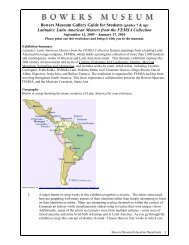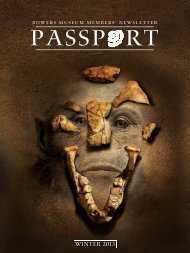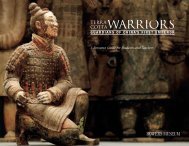Secrets of the Silk Road – Teacher Packet - Bowers Museum
Secrets of the Silk Road – Teacher Packet - Bowers Museum
Secrets of the Silk Road – Teacher Packet - Bowers Museum
Create successful ePaper yourself
Turn your PDF publications into a flip-book with our unique Google optimized e-Paper software.
Xinjiang Institute <strong>of</strong> Archaeology Collection<br />
L: 110cm<br />
The Beauty <strong>of</strong> Xiaohe", c. 1800-1500 BC<br />
<br />
Excavated from Xiaohe (Little River) Cemetery 5, Charqilik (Ruoqiang) County<br />
Xinjiang Institute <strong>of</strong> Archaeology Collection<br />
H: 152cm H: 60.8”<br />
Below are a couple <strong>of</strong> items people in <strong>the</strong> Tarim Basin area may have used when alive to protect<br />
<strong>the</strong>mselves from <strong>the</strong> harsh elements, but that were used as funerary items also.<br />
ACTIVITY 3: MYSTERY ITEM<br />
Without allowing your students to read <strong>the</strong> text for <strong>the</strong> item below, ask <strong>the</strong>m to tell you what <strong>the</strong>y<br />
think <strong>the</strong> item is. You’d be surprised at some <strong>of</strong> <strong>the</strong> wild guesses you’ll get!<br />
Bronze Eyeshade, 7 th -9 th Century<br />
<br />
Excavated from Tomb No. 227, Astana,<br />
Turfan<br />
Xinjiang Uygur Autonomous Region <strong>Museum</strong><br />
Collection<br />
L: 15cm W: 5.1cm<br />
L:6” W:2.04”<br />
<strong>Bowers</strong> <strong>Museum</strong> Education Department<br />
March 2010<br />
This mummy has been preserved extremely well, with <strong>the</strong> entire body covered in an even layer <strong>of</strong> thick,<br />
milky white substance. Quite shapely, <strong>the</strong> mummy’s e\belly is ra<strong>the</strong>r plump. Its eye sockets are deep-set<br />
with long, flaxen eyelashes. The bridge <strong>of</strong> <strong>the</strong> nose is high and straight, <strong>the</strong> mouth open slightly. The<br />
outline <strong>of</strong> <strong>the</strong> thin lips is prominent. The hair has also been covered in <strong>the</strong> thick, milky substance and<br />
<strong>the</strong>re are some casings from maggots stuck in it. When <strong>the</strong> milky substance is cleared away, it reveals a<br />
head <strong>of</strong> thick, flaxen hair with a natural part that has grown long down to <strong>the</strong> chest.<br />
Except for <strong>the</strong> head, calves, and feet, <strong>the</strong> entire body was wrapped in a wide, white wool cloak. The cloak<br />
has tassels that fan outward around <strong>the</strong> neck and shoulders. The wrap was closed over <strong>the</strong> front <strong>of</strong> <strong>the</strong><br />
deceased from right to left. At <strong>the</strong> chest are inserted two engraved wooden pins and two tamarisk sticks<br />
that have been burnt at <strong>the</strong> end. Poking through <strong>the</strong> cords on <strong>the</strong> right edge <strong>of</strong> <strong>the</strong> cloak are three small<br />
pouches, 5-6 cm in diameter. One <strong>of</strong> <strong>the</strong> bags is tied near <strong>the</strong> neck inside <strong>the</strong> cloak. The o<strong>the</strong>r two bags<br />
are tied to <strong>the</strong> cloak on ei<strong>the</strong>r side <strong>of</strong> <strong>the</strong> wooden pins. Inside all three <strong>of</strong> <strong>the</strong> bags are broken pieces <strong>of</strong><br />
ephedra, a kind <strong>of</strong> evergreen shrub with medicinal properties.<br />
There are numerous o<strong>the</strong>r striking attributes <strong>of</strong> <strong>the</strong> burial that merit separate description, e.g. <strong>the</strong> wooden<br />
phallus on her chest, <strong>the</strong> magnificent felt hat, <strong>the</strong> fine fur-lined lea<strong>the</strong>r boots, and <strong>the</strong> string skirt. All in<br />
all, this is a sumptuous burial stunningly beautiful woman who was much loved by those who interred her.<br />
This eyeshade was hammered from a piece <strong>of</strong> bronze placed over a mold. When it<br />
was discovered it was resting over <strong>the</strong> eyes <strong>of</strong> <strong>the</strong> tomb’s occupant. The style is not<br />
dissimilar from today’s eyeglasses. The border <strong>of</strong> <strong>the</strong> eyeshade is circled with small<br />
punch holes that would have been decorated with textiles such as cotton, hemp,<br />
silk, or brocade. In <strong>the</strong> center <strong>of</strong> <strong>the</strong> shade small holes have also been punched,<br />
allowing <strong>the</strong> wearer to look out on <strong>the</strong> world, but also avoid <strong>the</strong> wind and <strong>the</strong> sand.<br />
In real life Eskimo and Orochen people have <strong>the</strong> custom <strong>of</strong> wearing eyeshades to<br />
guard against <strong>the</strong> strong reflections <strong>of</strong> <strong>the</strong> sun from <strong>the</strong> ice and snow. People who<br />
live in plains also have <strong>the</strong> custom <strong>of</strong> wearing eyeshades to keep out blowing sands<br />
and ultraviolet radiation. However in <strong>the</strong> Turfan region during <strong>the</strong> Tang dynasty,<br />
eyeshades were not for actual use; <strong>the</strong>y were funerary goods used for covering <strong>the</strong><br />
eyes <strong>of</strong> <strong>the</strong> deceased. In <strong>the</strong> Astana tombs <strong>of</strong> this time it was customary to cover<br />
<strong>the</strong> face <strong>of</strong> cloth. The area where <strong>the</strong> eyes should be was cut from <strong>the</strong> face cover<br />
and <strong>the</strong>n an eyeshade like this one was sewn to <strong>the</strong> fabric.<br />
8





